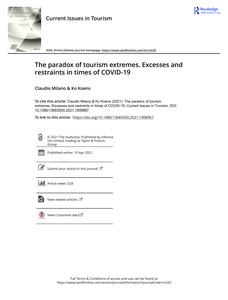This paper seeks to highlight underlying issues of the tourism system that have led to tourism extremes of too much or too little tourism. Five phases are recognized that reflect different ways of dealing with too much tourism over time, after which the impact of a sudden lack of tourism is investigated in light of future renewal processes. This discussion highlights the remarkable capacity of the tourism industry to adjust to rapidly changing circumstances and crises, even when these cause anguish to individuals and within societies at large. The paper thus seeks to contextualize the current discussions regarding the transformation of tourism post COVID-19. It highlights the complexity of changing a tourism that multiple stakeholders depend on or have grown accustomed to. To come to a more balanced tourism, it is necessary to not only come up with alternative visions and strategies, but also to engage with the political economy nature of tourism development. A future research agenda should therefore also discuss facets of entangled power, social exclusion, inequalities and class differences to come to new reference points of what actually constitutes a more inclusive tourism success.
MULTIFILE

The general aim of this research project has been to examine this phenomenon of tourism flow switching and consider the factors driving the geopolitical instability that can compromise destination security. On a more practical level the research has also examined what the reactions of Dutch tourists are to security threats affecting their tourism decisions and looked at the development of preventive measures against attacks by destinations and travel organisations. Finally, the research on the regional geopolitics of the MENA and European areas have together with the attitudes of Dutch tourists towards destination security been used as inputs into a scenario planning process involving the steering group of tour operators who originally commissioned this research, as participants. This process has focussed on macro environmental analysis, identification of key uncertainties, and the development of resilient strategies for the future.
DOCUMENT

This paper examines how a serious game approach could support a participatory planning process by bringing stakeholders together to discuss interventions that assist the development of sustainable urban tourism. A serious policy game was designed and played in six European cities by a total of 73 participants, reflecting a diverse array of tourism stakeholders. By observing in-game experiences, a pre- and post -game survey and short interviews six months after playing the game, the process and impact of the game was investigated. While it proved difficult to evaluate the value of a serious game approach, results demonstrate that enacting real-life policymaking in a serious game setting can enable stakeholders to come together, and become more aware of the issues and complexities involved with urban tourism planning. This suggests a serious game can be used to stimulate the uptake of academic insights in a playful manner. However, it should be remembered that a game is a tool and does not, in itself, lead to inclusive participatory policymaking and more sustainable urban tourism planning. Consequently, care needs to be taken to ensure inclusiveness and prevent marginalization or disempowerment both within game-design and the political formation of a wider participatory planning approach.
MULTIFILE
